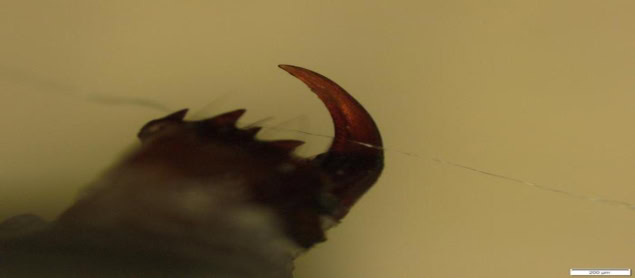
Spider silk is among the toughest of all biological materials, and scientists have long been puzzled by how spiders manage to cut it. Do they break it down by chemical means, using enzymes? Or do they do it mechanically, using their fangs? Researchers at the University of Trento in Italy have now come down firmly on the side of fangs, resolving a longstanding debate and perhaps also advancing the development of spider-fang-inspired cutting tools.
For spiders – especially those that spin webs – the ability to cut silk lines quickly and efficiently is a crucial skill. Previously, the main theory of how they do it involved enzymes that they produce in their mouths, and that can break silk down. This mechanism, however, cannot explain how spiders cut silk so quickly. Mechanical cutting is faster, but spiders’ fangs are not shaped like scissors or other common cutting tools, so this was considered less likely.
In the new work, researchers led by Nicola Pugno and Gabriele Greco studied two species of spiders (Nuctenea umbratica and Steatoda triangulosa) collected from around the campus in Trento. In one set of experiments, they allowed the spiders to interact with artificial webs made from Kevlar, a synthetic carbon-fibre material. To weave their own webs, the spiders needed to remove the Kevlar threads and replace them with silk ones. They did this by first cutting the key structural threads in the artificial webs, then spinning a silken framework in between to build up the web structure. Any discarded fibres became support for the web.
Pugno, Greco and colleagues also allowed the spiders to build webs naturally (that is, without any artificial materials present). They then removed some of the silken threads and substituted them with carbon fibre ones so they could study how the spiders cut them.
Revealing images
One of the researchers’ first observations was that the spiders found it harder to cut fibres made from Kevlar than those made from silk. While cutting silk took them just a fraction of a second, they needed more than 10 s to cut Kevlar. This implies that much more effort was required.
A further clue came from scanning electron microscope (SEM) images of the spider-cut silk and carbon fibres. These images showed that the fracture surfaces of both were similar to those of samples that were broken with scissors or during tensile tests.
Meanwhile, images of the spider fangs themselves revealed micro-structured serrations similar to those found in animals such as crocodiles and sharks. The advantage of serrated edges is that they minimize the force required to cut a material at the point of contact – something humans have long exploited by making serrated blades that quickly cut through tough materials like wood and steel (not to mention foods like bread and steak).
In spider fangs, however, the serrations are not evenly spaced. Instead, Pugno and Greco found that the gap between them is narrowest at the tip of a fang and widest nearest the base. This, they say, suggests that when spiders want to cut a fibre, their fangs slide inwards across it until it becomes trapped in a serration of the same size. At the contact point between fibre and serration, the required cutting force is at a minimum, thereby maximizing the efficiency of cutting.
“We conducted specific experiments to prove that the fang of a spider is a ‘smart’ tool with graded serrations for cutting fibres of different dimensions naturally placed in the best place for maximizing cutting efficiency,” Pugno explains. “This makes it more efficient than a razor blade to cut these fibres,” Greco adds.

Spiderweb structure inspires nanomechanical gravity sensor
The researchers, who report their work in Advanced Science, also conducted analytical and finite-element numerical analyses to back up their observations. These revealed that when a fibre presses onto a fang, the stress on the fibre becomes concentrated thanks to the two bulges at the top of the serration. This concentration initiates the propagation of cracks through the fibre, leading to its failure, they say.
The researchers note that serration had previously been observed in 48 families of modern spiders (araneomorphs) as well as at least three families of older species (mygalomorphs). They speculate that it may have been important for functions other than cutting silk, such as chewing and mashing prey, with the araneomorphae possibly later evolving it to cut silk. But their findings are also relevant in fields other than evolutionary biology, they say.
“By explaining how spiders cut, we reveal a basic engineering principle that could inspire the design of highly efficient, sharper and more performing cutting tools that could be of interest for high-tech applications,” Pugno tells Physics World. “For example, for cutting wood, metal, stone, food or hair.”



